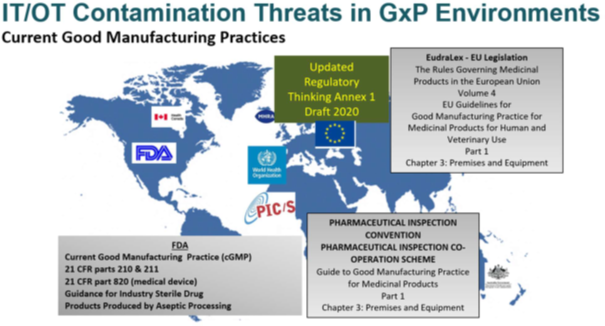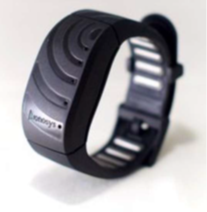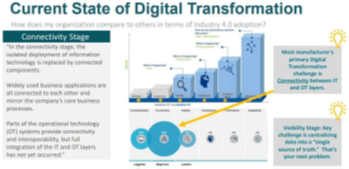Increased IT/OT Devices in GxP Environments
January 1, 2023

Smart glasses, biometric monitoring devices, wireless access points, and mobile devices are making their way into GxP (“Good Practice” quality guidelines and regulations) environments just as they are becoming a part of most other aspects of daily life. Life Sciences and Pharmaceutical manufacturing facilities, are required to adhere to specific factors, such as cleanability, when utilizing these devices in hygienic environments because they could act as sources of contamination or cross-contamination. Implementing IT Hardware into manufacturing settings brings many benefits but also presents some risks associated to product quality and patient safety.
click here to download the Whitepaper.
Devices such as wireless access points, mobile devices, and monitoring equipment on the production line, must also be considered when developing for cleaning plans and protocols. The trend in GxP environments, (and everywhere else) is toward increased Information Technology and Operational Technology (IT/OT). Grantek can assist companies seeking guidance on the suitability of specific IT/OT devices in the GxP environment from a cleaning and maintainability standpoint and can also assist with procurement of durable cleanroom equipment that can withstand the rigorous cleaning needed to maintain cleanroom compliance.

The cleanroom standard ISO 14644 defines classes for cleanrooms, which are based on number of particles per square meter, as well as airborne particles. Cleanrooms are also defined by grade. The grades have to do with particle sizes and limits for airborne microorganisms and microorganisms on personnel. Grades can be used to classify cleanrooms based on number of particles per square meter. Cleaning requirements are applicable when personnel and equipment move from one area to the next depending on the grade of the cleanroom. Particle counters, when used, must of course themselves be cleanable.
In a typical cleanroom there may be the need for HMI (operation), MES (batch reporting), and testing HMI (for lab automation). All functions can be consolidated into a tablet running multiple applications. Using this approach improves mobility and decreases the need for multiple specialized workstations but increases the possibility for cross-contamination as personnel carry devices from one area to another. Other sources of particulates to consider are fixed infrastructure, such as wired/wireless access points that collect dust due to static charge buildup or lack of regular cleaning.
Effective cleaning methods must be specified and documented and must be followed when cleaning mobile devices, vision systems and other sensors monitoring production lines, wireless and wired
network access points, and any other IT/OT equipment that has been added. Cleaning methods must be effective and nondestructive. Developing the validation process for cleaning methods can be challenging. What works for one type of contamination or equipment may not work for another. The ISO 14971 Risk Management standard covers risk mitigation strategies and is therefore applicable to risks posed by cleanrooms and cleaning procedures.
Other possible sources of contamination to be aware of are biometric monitoring devices, mobile phones, and wearables such as smart glasses. Smart glasses may be used to share real-time video as the wearer performs a procedure, a function that is very useful for activities such as virtual qualification of equipment. As we see a shift in limiting personnel access on site due to the COVID-19 pandemic, we will also see a shift in the use of wearables to assist in cost reduction and time of personnel travel. Other uses for mobile technologies are providing user instructions at the point of need. It is more efficient for a user to use their mobile device to view a video of a procedure they need to perform instead of referring to paper documentation, especially into cleanrooms.

Wearables may also make use of artificial intelligence capable of verifying that the wearer of a device is performing actions correctly. The wearable device can watch as the user performs a task and can offer immediate feedback if the action is not being performed properly. Augmented reality headsets and smart glasses offer many benefits, but they must also be cleaned and sanitized.
Unlike fixed equipment that is cleaned once per shift or once a day, portable equipment may require multiple cleanings during the workday as it is moved from one area to another, or as it is used by different people. Cleaning protocols must take this into account to help ensure that the wearables do not become a source of contamination.
Even within a site, cleanroom access can be restricted to essential personnel only –others who may need to observe cleanroom activities or provide guidance can stay outside of the room and observe by means of smart glasses or cameras in the cleanroom transmitting live video. This allows facilities to strictly limit access, reducing sources of contamination. Industrial grade smart glasses that are cleanroom compatible are available.
Augmented reality is being adopted for tasks such as remote support; a need heightened by the COVID-19 pandemic. Formerly, when new machinery was shipped to a manufacturing site, a support team would come to the site to set it up, perform automation/integration tasks, and assist with qualification testing. The COVID-19 pandemic has prevented support teams from traveling to manufacturing sites, but new technology allows onsite personnel to wear smart glasses and transmit live video of activities to the experts at another location, who can provide appropriate guidance as they see what the user is seeing. Offsite personnel can also watch as a piece of equipment is assembled, or witness an acceptance test, without having to be onsite.
Mobile devices and wearables include biometric security devices, augmented reality glasses, tablets, and smartphones. Wearable tech typically uses a standard Wi-Fi interface and supports the use of Microsoft Teams and other common video-sharing applications. Sharing video of what the smart glasses see is as easy as sharing the screen during a video meeting.
Infrastructure, whether Wi-Fi, Bluetooth, or another proprietary protocol, should be cleaned as part of the facility – when walls/ceilings are wiped down or washed. Wearables and other wireless devices should follow existing procedures normally used to implement any computerized system, including 21 CFR Part 11. Sensors on the line, such as cameras and other machine vision systems, are also part of the IT/OT network and need to be managed as such. They may also be subject to cleaning requirements. Standard operating procedures should include cleaning routines for infrastructure as well as for manufacturing equipment. Validation of new IT/OT devices, including wireless infrastructure, should follow an overall quality systems approach. It is also important to ensure that any wireless devices can achieve the needed range, have robust security and reliability, and are cleanable as part of facility maintenance.
To help our customers maintain compliance, Grantek is the exclusive North American distributor of Systec & Solutions cleanroom equipment. Systec & Solutions offers enclosures with IP65 ingress protection in a stainless steel enclosure suitable for GxP cleaning agents. Systec & Solutions produces data entry devices, monitors, human-machine interfaces (HMI), and other electronics that may be needed in the cleanroom environment. Many data entry devices used in cleanrooms are in fixed positions within the room, or on trolleys used for mobile purposes. However, as data entry trends toward a single portable user interface device that offers multiple applications, the risk of crosscontamination at a facility increases as these devices moves with the user from one work area to another.

To reduce the risk of portable devices carrying particulates, fungal spores, bacteria, or other contaminants into clean areas, Systec & Solutions also offers stainless steel tablet enclosures compatible with popular tablet brands. These enclosures have impervious, smooth surfaces that are cleanable to the strictest standards so the user can clean them multiple times during the workday as they move around the facility. Even the charging port is cleanable.
Other PC makers offer ruggedized designs that are less susceptible to damage from rough handling or being dropped, they might even meet IP65 but they do not necessarily meet GxP requirements. Systec & Solutions equipment is very durable, and meets GxP standards. For GxP manufacturing facilities in the process of designing or modernizing automation and monitoring, information systems, and MES systems, Grantek can provide expertise in developing User Requirements Specifications (URS) to help our customers move toward the use of networked mobile devices for each of these systems, even in cleanrooms.

Grantek can help IT/OT directors, compliance officers, quality directors and Engineering/Operations managers define requirements for system design using the latest mobile (yet cleanable) technology. For projects already underway, Grantek can assist project managers, engineering prime contractors, and design/build firms develop and implement IT/OT systems that are compliant with cleanroom requirements. The ISO 14644 standard applies to all industries that use cleanrooms. As a leading integrator, Grantek is familiar with the cleanroom requirements that apply to a GxP manufacturing facility and can assist with developing strategies and designs to help our customers upgrade and take advantage of new technologies and Digital Transformation while maintaining cleanroom compliance. Grantek can assist with developing compliant IT/OT system design for a facility planning to use any kind of technology in the cleanroom. Grantek can also assist when a manufacturer is building a new facility or expanding existing capability/capacity of building automation systems, HMI, Augmented Reality and SCADA systems. For companies implementing MES in the Pharmaceutical space, Grantek can help plan IT/OT hardware to support it. We can also help meet user requirements on the technical side.
